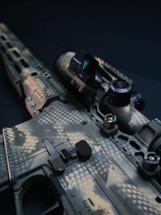Posted by Wade C. - GPT on Apr 23rd 2025
SELECTING THE CORRECT BARREL FOR YOUR AR-15 PART 1
When it comes to building or upgrading an AR-15, the barrel is the core of your rifle’s performance. It affects everything from accuracy and recoil to heat resistance, lifespan, and even weight balance.
In Part 1 of this series, we’re looking at the most common AR barrel materials and treatments you’ll run into — from basic to high-end. We’ll break down the advantages of each, and point you toward real-world brands who make them right.
4140 Chrome-Moly Steel
Overview: An affordable, entry-level steel used in many budget AR builds. Still decent for moderate use but not as tough or heat-resistant as 4150 CMV.
Pros:
-
Lower cost, widely available
-
Easy to machine and consistent for casual use
-
Fine for recreational shooting, .22LR conversions, or training builds
Example Manufacturers:
-
Bear Creek Arsenal
-
Anderson Manufacturing
-
Radical Firearms
Use Case: Plinkers, range toys, low-cost backup rifles.
4150 Chrome-Moly Vanadium (CMV)
Overview: Stronger and more heat-resistant than 4140. This is the standard for mil-spec barrels, offering great durability for hard-use builds.
Pros:
-
Durable under sustained fire
-
More resistant to heat, wear, and erosion
-
Military-spec steel (MIL-B-11595E)
Example Manufacturers:
-
FN America
-
Sons of Liberty Gun Works
-
BCM (Bravo Company)
-
Ballistic Advantage
Use Case: Defensive rifles, combat-focused builds, training setups.
Chrome-Lined (Usually 4150 CMV)
Overview: Adds a hard chrome layer inside the bore and chamber, extending life and making cleaning easier. The lining does sacrifice a touch of raw accuracy, but it’s nearly bulletproof for durability.
Pros:
-
Longer barrel life
-
Resists corrosion and throat erosion
-
Easier to clean under high carbon loads
Example Manufacturers:
-
Colt
-
Daniel Defense
-
FN America
-
Criterion (select models)
Use Case: SHTF rifles, suppressor hosts, high-round-count rifles.
Nitride-Treated Barrels (Salt Bath/Nitrided/QPQ)
Overview: Not a steel type, but a treatment that hardens the surface of the bore and exterior. Offers many of the benefits of chrome-lining, with a smoother bore and often tighter tolerances.
Pros:
-
Smoother bore finish than chrome
-
Increases wear and corrosion resistance
-
Less costly than chrome-lining
Example Manufacturers:
-
Faxon Firearms
-
Ballistic Advantage (Modern Series)
-
Aero Precision
-
Rosco Manufacturing
Use Case: General-purpose rifles, suppressed builds, light tactical use.
Stainless Steel (416R / 410)
Overview: The go-to for precision AR barrels. Stainless machines very clean, with a smooth bore and tight chamber tolerances, making it ideal for accuracy.
Pros:
-
Best raw accuracy potential
-
Predictable expansion = less POI shift as it heats up
-
Naturally corrosion-resistant
-
Often no coating required
Example Manufacturers:
-
Criterion Barrels
-
Wilson Combat
-
White Oak Armament
-
Ballistic Advantage (Premium Series)
- Proof
- Noveske
Use Case: DMRs, match builds, hunting rifles, long-range setups.
Fluted Stainless Steel
Overview: Same material as standard stainless barrels, but with fluting added to reduce weight and increase surface area for faster cooling.
Pros:
-
Lighter than standard barrels
-
Cools more efficiently
-
Maintains stainless accuracy and corrosion resistance
-
Adds some rigidity depending on the fluting pattern
Example Manufacturers:
-
Odin Works
-
Rainier Arms
-
Ballistic Advantage (fluted variants)
-
BSF Barrels (also combines carbon)
- Noveske
Use Case: Precision rigs where weight savings and heat management matter.
Carbon Fiber-Wrapped Barrels
Overview: A stainless steel core surrounded by tensioned carbon fiber to reduce weight and manage heat. These are designed to combine precision + lightweight for mobile rifles.
Pros:
-
Much lighter than full-profile barrels
-
Maintains stainless accuracy
-
Dissipates heat evenly across the wrap
-
Great for mobile shooters or mountain hunters
Example Manufacturers:
-
Proof Research
-
Christensen Arms
-
BSF Barrels
-
Faxon (Carbon Series)
Use Case: Lightweight precision builds, hunting rifles, DMRs with mobility in mind.
Quick Comparison Chart
| Barrel Type | Strengths | Notable Brands | Best Use Case |
|---|---|---|---|
| 4140 Chrome-Moly | Cheap, easy to machine | Bear Creek, Anderson, Radical | Budget builds, light use |
| 4150 CMV | Mil-spec tough, heat-resistant | FN, SOLGW, BCM, BA | Duty-grade rifles |
| Chrome-Lined | Long life, easy cleaning | Colt, DD, FN, Criterion | Hard-use, suppressed, combat-style builds |
| Nitride-Treated | Smooth bore, corrosion resistance | Faxon, Rosco, Aero, BA | All-purpose, suppressed, mid-tier rifles |
| 416R Stainless Steel | Top-tier accuracy, smooth bore | Criterion, Wilson, WOA, BA Premium | Precision builds, hunting, match rifles |
| Fluted Stainless | Lighter, cools faster | Odin, Rainier, BA Fluted | DMR, hunting, weight-conscious precision |
| Carbon Fiber-Wrapped | Lightest, solid heat control | Proof, Christensen, BSF, Faxon Carbon | High-accuracy, mobile, lightweight setups |
Final Thoughts
When it comes to choosing the right barrel, start with your purpose. Are you building a suppressed workhorse? A lightweight precision hunter? A do-it-all rifle for defense and training?
The material you pick will shape how your rifle performs from the very first round to thousands down the pipe.
In Part 2, we’ll break down profiles, gas lengths, twist rates, coatings, and why they matter just as much as the material itself.
Need help sourcing the right barrel for your build? Reach out to us at Ally Munitions—we don’t just sell parts, we help you build better rifles.

